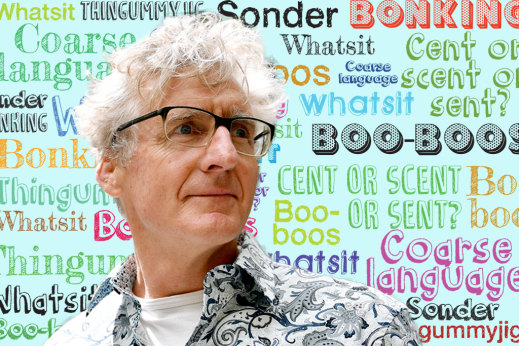
“Imagine you and me are moving tanbark.” Better still, don’t imagine it. Delete the idea from your mind and pretend you never read that sentence. Or so I’d wished in early March after the backlash I copped, a tanbark pile-on.
Lewis Kaplan, Simon Rice, Marina Garlick – the chorus was extensive, some 20 emails in all, each writer challenging my use of “me”, the first-person singular’s object form, rather than “I”, the subject form. To summarise the response: “David, it’s surely you and I that are moving the tanbark, not you and me.”
A grammatical inconsistency in a previous column sparked a veritable pile-on.Credit:Jo Gay
Turns out you’re right. Mostly. In my defence, I do have a leg to stand on, albeit one, since English is impossible to keep within strict borders, much like tanbark. To present my case, I hereby call the first witness, Dr Navid Sabet, director of Grammar Train, a Canberra-based agency that upskills teachers in the spooky arts of syntax and tense.
His response: “Verbs with reporting functions, such as ‘imagine’ or ‘remember’, are often followed by a noun clause, also called a ‘that’ clause.” Reread the column’s opener, and you’ll note I’d omitted “that”, the subordinating conjunction. We often do so when speaking informally, or seeking brevity.
Turning to orthodoxy, the finite structure would read: “Imagine that you and I are moving tanbark.” Whereas the non-finite choice could be: “Imagine you and me moving tanbark.” Notice the absence of “are” in Example 2, changing finite to non-finite. Both alternatives hold water. Both deserve a tick in your NAPLAN paper.
For better or worse, however, my earlier column had a bob each way, ditching “that” and retaining “are”, devising a clumsy non-finite finite landscaping solution. As Dr Sabet adds, “By using ‘are moving’, you have included a finite verb, so technically because you have a finite clause, you need ‘I’, the subject pronoun.”
Cross-eyed, the sentence served two modes, a hybrid demanding both the subject pronoun and object pronoun in one messy sweep, which is impossible. You can do it – grammatically, I mean. “You” can be both subject and object, but not “I”. Or is that “me”? In a bid for the casual voice, I’d somehow straddled two clauses, ending up in limbo, needing a wheelbarrow to collect the brickbats.
Then there’s the verb-thing, or what I call the sentence’s implicit subject. The defence calls its second witness, Deb Doyle, a Sydney grammando who helps communicators advance their written English. Deb was quick to discuss transitive verbs, which “carry the action across from subject to object. A trans-Pacific flight, say, carries you from one country to another.”
Imagine, as a transitive verb, had been my distraction. Lost in the wild, you don’t yell “Help I!” Well, you could try, but pedants might ignore you. Rather we use the object pronoun, or “me” in this case, as transitive verbs demand a target, an end-point, just as kiss demands a kisser as much as its kissee.
Verb-wise, imagine is in the same boat. Imagine what, you ask. Imagine you and me moving tanbark… In hindsight, that’s what I should have written, plumping for “me” as one half of your projected image. In my mind, the reader (or you) had been the implied grammatical subject of my sentence. Using the imperative mood, I’d asked the off-page you to picture the in-garden you (and me) shifting tanbark. Except I fell on my arse by adding “are” to the picture, splicing two clause structures, converting a simple weekend chore into one heavy slog. Reader, I nearly put my back out.
A cultural guide to going out and loving your city. Sign up to our Culture Fix newsletter here.
To read more from Spectrum, visit our page here.
Most Viewed in Culture
From our partners
Source: Read Full Article
